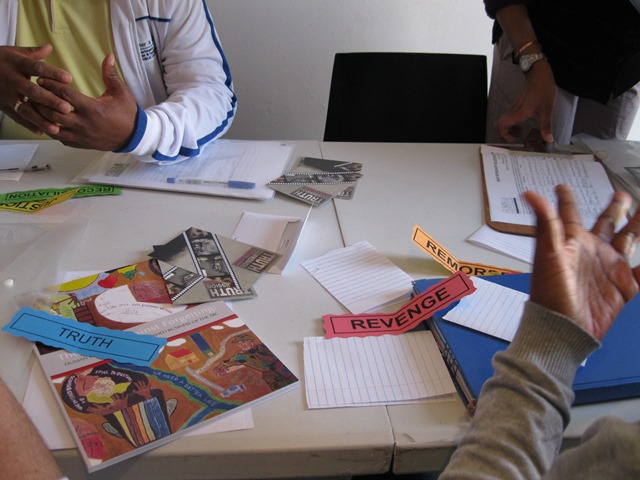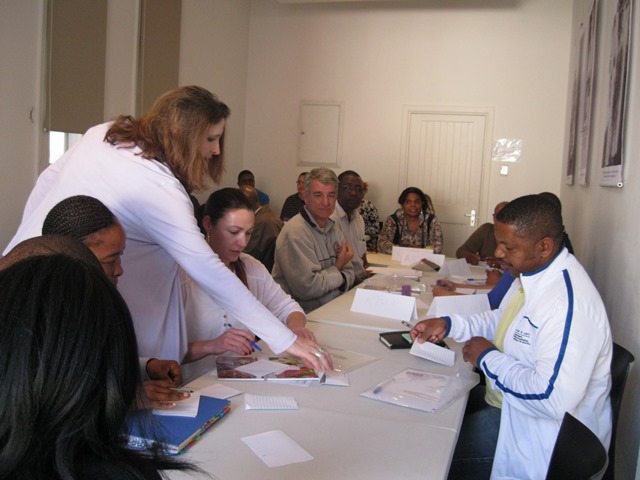 SAHA has been running workshops for history educators since 2008 as part of SAHA's ongoing efforts to use history as a lens for exploring issues of justice, human rights and responsibilities. These workshops are intended to support educators in helping young people to become active, tolerant and responsible democratic citizens who value diversity, human rights and peace.
SAHA has been running workshops for history educators since 2008 as part of SAHA's ongoing efforts to use history as a lens for exploring issues of justice, human rights and responsibilities. These workshops are intended to support educators in helping young people to become active, tolerant and responsible democratic citizens who value diversity, human rights and peace.
The most recent educators workshop, held on 22 August 2015, was about teaching the TRC. Facilitated by Michelle Friedman, 20 educators from different schools attended - SAHA even had attendees from other provinces. The teachers all agreed that this workshop was particularly helpful for giving guidance on how to teach students about the TRC.
The TRC was established in 1995 under the through the Promotion of National Unity and Reconciliation Act of 1995, with the mandate to investigate gross human violations under apartheid. It was hoped that the TRC's legacy would hold those responsible accountable, and offer recourse and remedies to ensure that the new South Africa upholds ideals of inclusion and democracy. Whilst the TRC is a complex subject, it is imperative that the topic is taught in an engaging and learner-friendly way.
The importance of the inclusion of the TRC in the history curriculum cannot be under-estimated. The TRC was an investigative mechanism that allowed victims and survivors of the past atrocities to publically narrate their stories to record our history for the future generation. Teaching the TRC gives today's learners context of their current freedoms and the background to understanding the systemic inequality that South Africa inherited from the apartheid regime.

Learners might have in-depth knowledge of the democratic constitution of South Africa, through their awareness of the Bill of Rights and the Constitution - but this knowledge must be grounded in an historical understanding of how South Africa transitioned from apartheid rule to democracy. Teaching the TRC brings together knowledge of our transition and learners' lived democratic present. Teaching this subject also forms part of another goal of the Commission itself: understanding the past to ensure that the same violations do not happen again in future.
South Africa’s transition to democracy came with many compromises and negotiations; the TRC was one of the steps that were taken towards nation building and healing the wounds of the past to maintain a healthy democracy and continue to strive for equality. It is thus an essential part of the school curriculum.
Follow the links below to learn more about SAHA's work with learners and educators, and our available resources:
The Battle Against Forgetting: human rights and the unfinished business of the TRC
Between Life and Death: Stories from John Vorster Square (DVD + educators' guide)
Meeting history face-to-face: A guide to oral history (book & DVD)
SAHA in the Classroom: using primary sources to teach apartheid history (1976 - 1994)
Voices from our Past (CD and educators' guide)






 SAHA has been running workshops for history educators since 2008 as part of SAHA's ongoing efforts to use history as a lens for exploring issues of justice, human rights and responsibilities. These workshops are intended to support educators in helping young people to become active, tolerant and responsible democratic citizens who value diversity, human rights and peace.
SAHA has been running workshops for history educators since 2008 as part of SAHA's ongoing efforts to use history as a lens for exploring issues of justice, human rights and responsibilities. These workshops are intended to support educators in helping young people to become active, tolerant and responsible democratic citizens who value diversity, human rights and peace.
